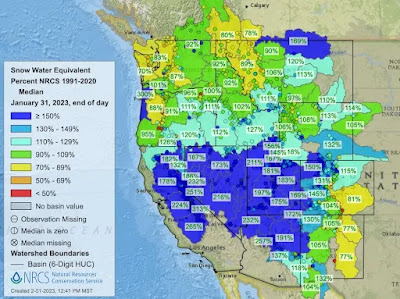That situation endangers water supplies for something like 40 million people. Since the dams in front of the two lakes normally generate lots of electricity, even the grid out west has been threatened.
This isn't just a problem for western states supplied by the Colorado River. If things get really bad out there with water shortages and electrical generation, the economic ripple effects would be felt nationwide, and probably worldwide. Including here in the Brave Little State of Vermont.
However, as you also might have heard, or seen in this here blog thingy, there's been a welcome ton of rain and mountain snow out west, including in much of the Colorado River basin.
Water levels in Lake Mead and Lake Powell have crept up a little this winter. And, if the spring snow melt behaves well, a little bit more water will enter to the two giant reservoirs.
So all good, right?
Um, no.
The region that includes the Colorado River basin has been in a more than two-decade long mega-drought. One winter with great precipitation does not erase something like that. It would take years and years of wet weather to set things right.
 |
| Though drought has eased in the West, it's still definitely a factor as the latest U.S. Drought Monitor, released on February 2, shows. |
Climate change has made the West hotter, and generally drier. Hotter weather creates more evaporation, so things dry out more quickly. This winter's rain and snow is bucking the trend of a drier climate.
That could just be a part of natural variability superimposed on the drier climate. Chances are, this stormy western winter could be just a temporary reprieve.
As Yale Climate Connections notes:
"Some experts worry it could further delay the hard work that managers of the watershed must do to keep it healthy and make its service more inclusive as the climate grows hotter and more parched.
'As soon as water supplies increase, people tend to stop paying attention,' said Kathy Jacobs, director of the University of Arizona's Center for Climate Adaption Science and Solutions said in an interview. 'I hope people realize that even one year of good flows doesn't mean we have a trend in that direction. We really need a long-term solution.'"
Decades old water usage agreements among western states are based on river gauge readings between 1900 and 1920.
That basis is way too optimistic considering scientists have since found that those 20 years more than a century ago were among the wettest in 1,400 years.
Oops.
The drought, and low water levels in Lakes Mead and Powell got so low by last June that the U.S. Department of the Interior demanded states that use water from the Colorado River come up with a plan that sharply reduces usage.
That agreement is still in the works, though Yale Climate Connections notes it's good that at least the states agree sharp cutbacks are needed, even if they don't yet agree on just how to accomplish that.
For more info, read the entire Yale Climate Connections article here.


No comments:
Post a Comment